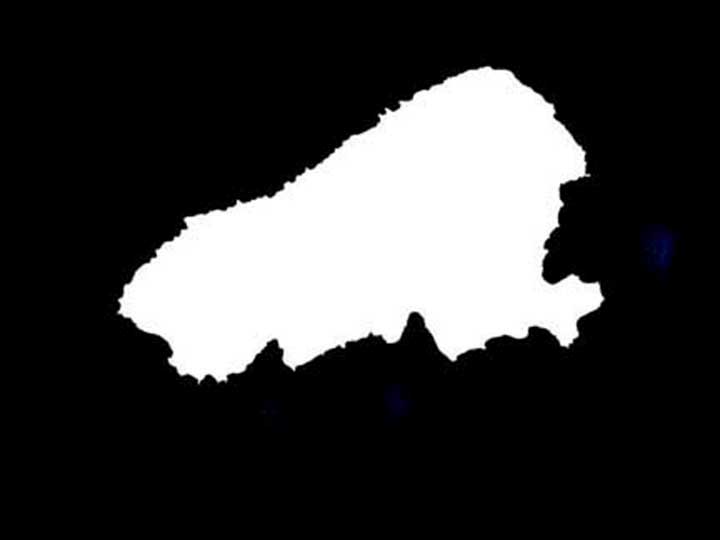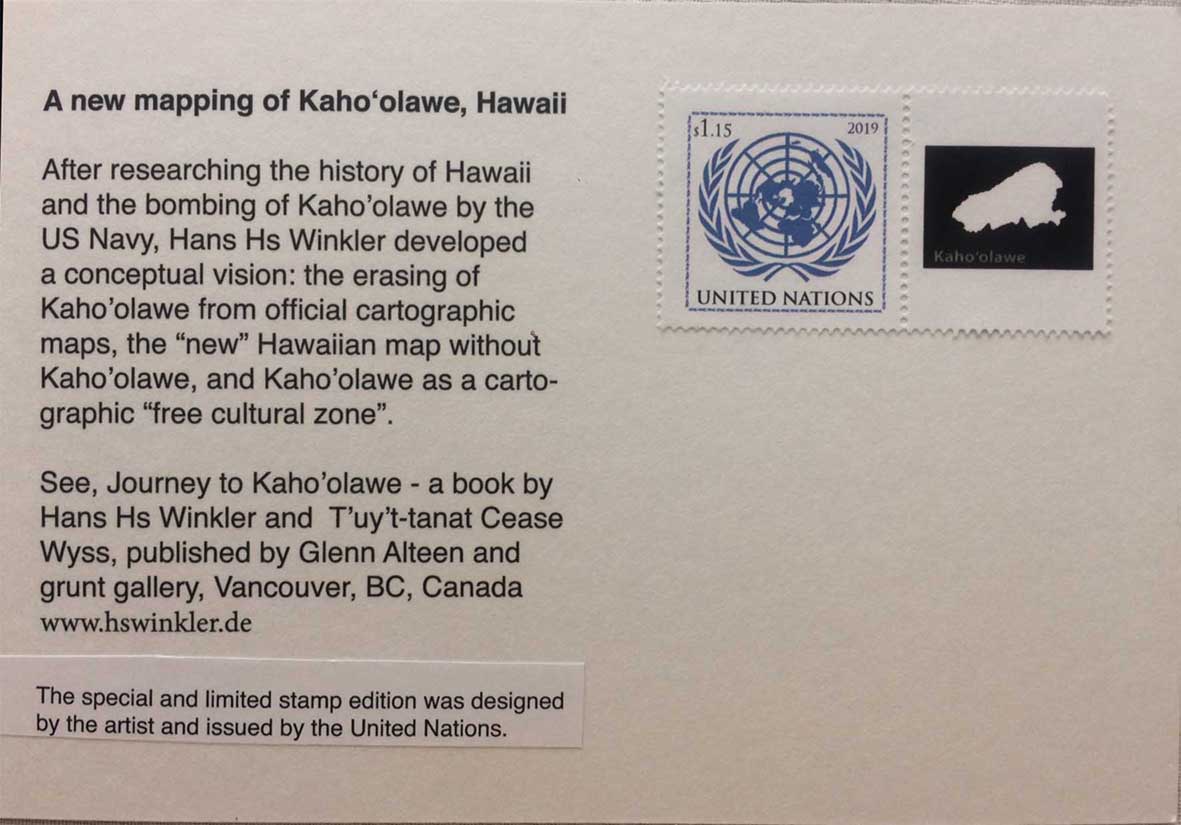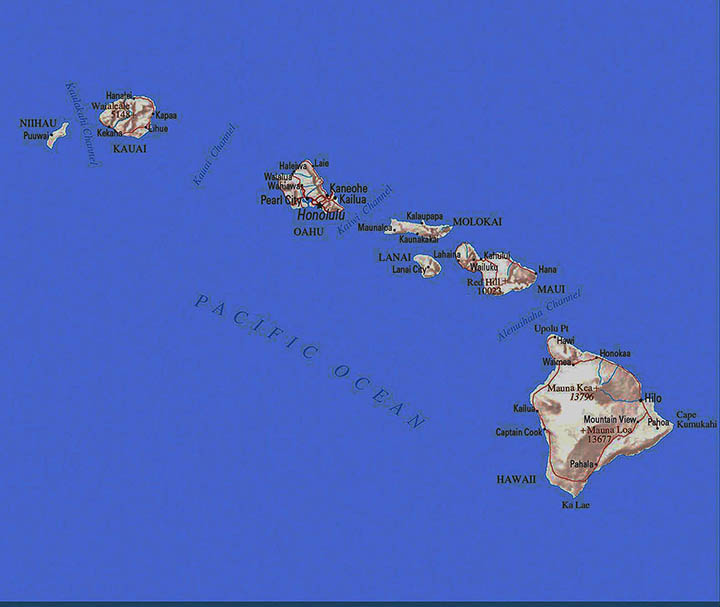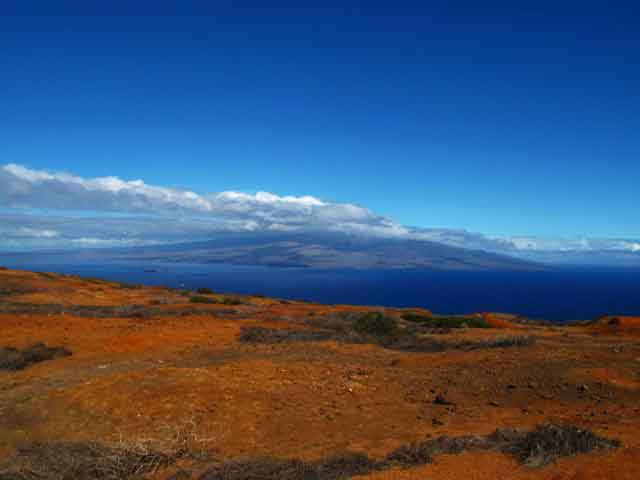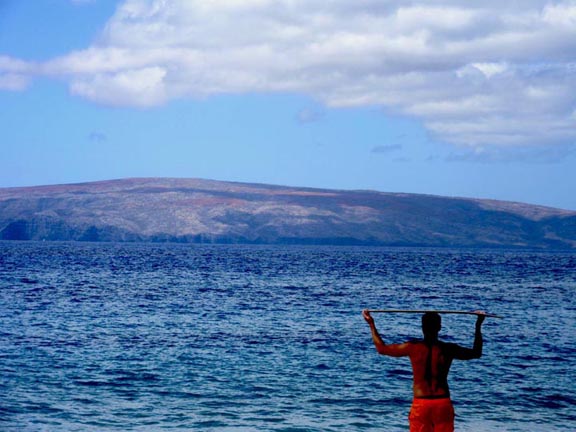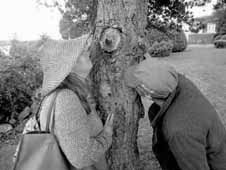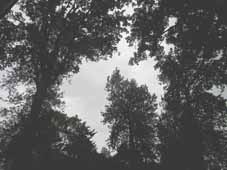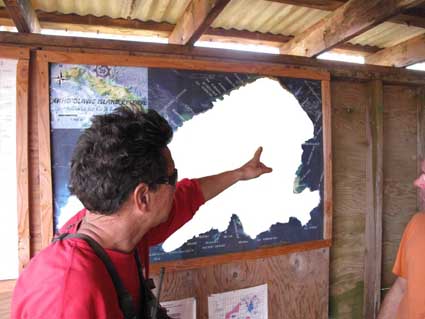journey to kaho'olawe :
New Mapping of Kaho’olawe, Hawaii
In “The Journey to Kaho'olawe” Hans Winkler focuses on the colonial past and present of the island. The first result is a new mapping in which the significance of Kaho'olawe is made clear. In 2019, official maps of Hawaii without the island of Kaho'olawe were published. Hans Winkler encounters this disappearance with his own map, postcard, and stamp, which mark the empty space. The special and limited stamp edition was now issued by the United Nations.
Neue Kartographierung von Kaho’olawe
In „Die Reise nach Kaho’olawe“ beschäftigt sich Hans Winkler mit der kolonialen Vergangenheit und Gegenwart der Insel. Erstes Resultat ist eine neue Kartographierung, in denen der Stellenwert von Kaho’olawe verdeutlicht wird. 2019 wurden offizielle Karten von Hawaii ohne die Insel Kaho’olawe publiziert. Hans Winkler setzt diesem Verschwinden eine eigene Landkarte, Postkarte und Briefmarke entgegen, die gerade die Leerstelle markieren. (Diese spezielle und limitierte Briefmarken Edition ist jetzt von den Vereinten Nationen herausgegeben worden)
Press Release
Book Launch: Journey to Kahlo’olawe - an artists’ publication by Hans Hs Winkler and T’uy’t-tanat Cease Wyss, published by grunt gallery, Vancouver, BC, Canada
In conjunction with the launch of the publication grunt gallery and the artists will present a week long series of events celebrating Kahlo’olawe and the Kanaka presence in BC from May 25 to the 29th. All events are free.grunt gallery is pleased to announce the publication of the Journey to Kahlo’olawe an artist publication by Hans Winkler and T’uy’t-tanat Cease Wyss. The artist book is the result of the 4 year process centred on the Hawaiian Island of Kahlo’olawe a sacred Island to the Hawaiians in recovery after being occupied as a practice range by the American military. Returned to the Hawaiians in the 1990’s the site is being remediated and returned to its natural state.
During the first trip to Kaho’olawe Hans Winkler studied archaeological sites and their connection to navigation systems and tattoos worldwide. After studying the Hawaiian history he developed the conceptual vision of Kaho’olawe as a cartographic “free cultural zone.”
The publication also documents the Kanaka presence in British Columbia since the late 1700’s when native Hawaiians travelled to BC with many staying and marrying into the Squamish peoples on the BC coast. With texts by Wyss and historians Jean Barman and Bruce McIntyre Watson in addition to Hans Winkler the book represents the four year research project by the artists.
Events as follows:
Thursday May 25, 7 pm - Booklaunch at grunt gallery, 116- 350 East 2nd Avenue
Welcome by Salish artist T’uy’t-tanat Cease Wyss. Music and Ghost Stories by Os12.
Friday May 26, 7 pm Mini Luau at the Chief Joe Mathias Centre in North Vancouver, 100 Lower Capilano Road celebrating the Kanaka Presence in BC MC T’uy’t-tanat Cease Wyss with Bob Baker, Hula Spirit Dancers, Barbara Wyss and more
Sunday May 28, 4. 30 pm at the Tiki Room in the Waldorf Hotel, 1489 East Hastings Street MC By Hans Winkler Featuring a film by George Helm, Kaho'olawe Aloha Aina, 1977, 30 MIN as well as a reading of Stephen Kane-a-I Morse, Kaho'olawe, First Landing, Surf movies and the Spirit Hula Dancers.
Monday May29, 3pm @ Mountainview Cemetery, Celebration Centre, 5455 Fraser Street featuring a tour of Kanaka graves by historian Jolene Castillou Cumming and a conversation at the Celebration Centre with Barbara Wyss and Kanaka historian Jean Barman
The artists and grunt wish to thank Dr Juve Vega for support of this publication.
grunt gallery would like to acknowledge our funders: The Canada Council for the Arts, The British Columbia Arts Council, the City of Vancouver, BC Gaming and the Audain Foundation, as well as individual donors and supporters.
http://grunt.ca/journey-to-kahoolawe/http://do604.com/events/2017/5/25/journey-to-kaho-olawe
Kaho’olawe is one of the 8 islands of Hawai’i. It is about 11 miles long and 7 miles wide and rests 7 miles away from the next island, Maui, and 16 miles away from Lanai.
In traditional Hawaiian cosmology, the island is a sacred place. Named after the Hawaiian and Polynesian god of the ocean currents and navigation, it is known as the kino lau (body form) of the god Kanaloa. It is the residence of Ka-moho-ali’i, the shark god brother of the volcano goddess Pele and is said to have been born of the union of earth mother (Papa) and skyfather (Wakea). It is considered as a place of refuge. (1)
Kaho’olawe is a cultural and artistic center and as a navigation marker called Kohemalamalama O Kanaloa or Kanloa. For over a thousand years it was used as a natural guide for the native navigators who sailed without instruments, dependent upon islands, sun and stars, currents and winds to get them safely to their destination.
The high central part of island, offering a unique over view of the Hawaiian Islands, was used as a traditional training school by Kahuna priests. It figured significantly in the long voyages between Hawaii and Tahiti. The island’s southern tip was a launching place and ceremonial area for such voyages.
In its varied history, the island was used by colonists in the 19th century as a penal colony and a site for sheep and cattle ranching, and in 1940 it was taken over by the U.S. Navy as a target site for bomber planes and gunnery practice during WWII and the Vietnam War. In 1990 Kaho’olawe was placed under the administration of the Kaho’olawe Island Reserve Commission after civil protest and strenuous lawsuits forced the return of the island to Hawaiian rule.
The island is currently uninhabited and primarily accessible to Native Hawaiians/ Polynesians only for cultural and spiritual purposes or restoration and planting work/ re-vegetation.
The journey to Kaho’olawe of Cease Wyss and Hans Winkler became a journey through the history of human beings and the “new civilisation” in the Pacific, written by the American/Anglo-Europeans since the 18th century and told through oral history by Indigenous people in British Columbia and by native Hawaiians for more than 1500 years.
The core of Wyss and Winkler’s project was to create different conceptual art works within the context of the island and its symbolical character, and in relationship to other cultures and nations.
Hans Winkler was first invited to the island in 2013. This visit triggered his active participation as an outsider and artist in the development of the future of the island. During the first trip to Kaho’olawe he studied archaeological sites and their connection to navigation systems and tattoos worldwide. After studying the Hawaiian history he developed the conceptual vision of Kaho’olawe as a cartographic “free cultural zone.”
Research on the project led him to the Georg Forster and James Cook Collection at the University of Göttingen, which houses one of the largest collections of 18th century Polynesian art in Europe. He is attempting to bring back from the archive of the German University the “feather sculpture” of Ku – one of the four major Hawaiian deities – to Kaho’olawe.
For the further development of the project, Winkler stayed in Kaho’olawe in January 2014, together with Canadian Squamish artist Cease Wyss. She lives in Vancouver and her cultural and hereditary roots go back to both Hawaiian and First Nations peoples in British Columbia.
In collaboration with native Hawaiians as well as with Indigenous people in Canada/BC, they worked on the next step of the project, which included a 5-day performance/ and presentation of the book in Vancouver, BC, in May 2017, with the support of grunt gallery and Juve Vega for support of this publication.
ARTIST BIO
Hans Winkler (b. 1955) is an artist and curator who lives and works in Berlin and New York. Since 1999, he has been Visiting Artist and Lecturer at the San Francisco Art Institute. Winkler’s art projects include The Escape of the Iceman/Ötzi (2008) in collaboration with the Department of Archaeology at EURAC, Bolzano and the Museum of Modern Art;Held Saga (2005) at Adademie der Kuenste, Berlin. In 2005, Recently co-curated exhibitions include California Conceptual Art (2010) with Paul Kos and Tony Labat at ar/ge kunst in Bolzano, Italy; and legal/illegal (2004) with Helen Adkins and Kai Bauer at NGBK, Berlin.
T’uy’t-tanat – Cease Wyss is an Ethnobotanist, Media Artist, Curator, Educator and Activist from the Skwxw’u7mesh, Sto:Lo, Hawaiian & Swiss Nations. Cease shares her knowledge of the rich and diverse cultural stories that originate from the ancestral lands of the local First Nations with a number of community networks. Cease is a media artist with 25 years experience in this field. She has produced various formats of media art, as well as being a mentor in her field for close to 15 years. She is also an ethno-botanist, traditionally trained in this field by Indigenous Elders. Her work involves site-specific and culturally focused teaching with storytelling as her means to sharing knowledge.
April 12th 2016 - Posted by Sydney Ball
“Surrounded by a possible serene beauty, grief and sadness, love and hate, what encounters do we inscribe into our psyches and into our beings, what can art do to fulfil a mandate of hope and agency. What can we contribute.” – thirstDays Project curator/artist-in-residence Jayce Salloum at VIVO Media Arts Centre
The subtitle of grunt gallery’s monthly series Spark: Fireside Artist Talks, points towards where the talks take place…
in the community and conversational site of the Native Education College Longhouse, over lunch in the afternoons. Last Thursday Cease Wyss, media artist and ethno-botanist, and Hans Winkler, a German artist and curator, sat down in the informal space to discuss their connection, observations, and work with Kaho‘olawe Island in Hawaii.
The conversation centred around the violent history of Kaho‘olawe, which was used to test bombs and explosives by the U.S. Army, who seized the island under martial law after the attack on Pearl Harbour in 1941. The bombing, combined with the island’s unique colonial plight of rampant goats (brought originally by Captain Vancouver in the late 18th century), has left the island with an uninhabitable desert like terrain, with much of its land still unsafe due to undetonated explosives. The land has been “given back” to Hawaii and the Kaho’olawe Island Reserve Commission (KIRC) and Protect Kaho’olawe ‘Ohana (PKO) determines who has access to the island by invitation, usually only to volunteers and those with Hawaiian ancestry.
For the two artists Kaho’olawe was a site to explore a very valuable question in the project of healing: “what can we contribute?” The fulcrum for this work is, I think, a phrase Wyss during her talk that Thursday: the “cultural handshake.” The handshake, or the site of human connection as a literal touch, is an interaction with Wyss that I feel privileged to have received one week prior to that edition of Spark. The program at thirstDays no. 02: Rematriation and other ruminations, at VIVO media arts centre, was closed by Wyss, who hosted a “reciproci-tea party,” in which she first instructed the room to get into a circle, an ideal shape for receiving, and gifted us tea that she had made from the plants native to the Squamish and Hawaiian lands of her ancestry. In this practice she grabbed each person’s hands individually and thanked them.
This followed a piece by Skeena Reece, Touch Me (2013), in searches to make connections with different times, places, and people, and it is not satisfied in narrowing its reach or restraining its energy. It’s the extension of Wyss’ “cultural handshake.” So again, what is it we can contribute? In the case of Kaho’olawe, Wyss is using her practices as an ethno-botanist to help restore the plants indigenous to the island. She also has plans to start ephemeral art projects in collaborations with the Hawaiians who visit the island by using the shells and bombs found in the land.
For Winkler, he saw the nature of Kaho’olawe as a site of spiritual and cultural teachings as a very important part of preservation. This got him to seek out the aid of an ex-CIA hacker to help with the project of erasing Kaho‘olawe from official maps. It’s a project of sovereignty, to keep hidden one of the few places in Hawaii where access has not been granted to the general public. Kaho’olawe exists as a refuge from commercial interests and tourism, and a simultaneous reminder of grief and destruction. It is interesting that the place that was stolen from its people is now one of the only places in Hawaii that Hawaiians can use to practise ceremony in peace. This and the history of the island have kept it as a deeply spiritual place for many despite its land having been visibly changed by colonialism. Wyss reflected the thorny idea that people go to learn their culture and language in “one of the heaviest places.”
http://mediademocracyproject.ca/2016/04/1872/
back
